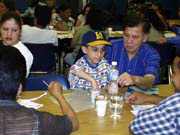More than 100 parents, students, teachers and principals joined the New Jersey United for Higher School Standards organization at Robert Waters School in Union City on May 2 to discuss new state mandates for school curricula.
NJUHSS is a statewide alliance formed in 1999 to provide parents and other community members an open forum to discuss the state’s Core Curriculum Content Standards. The organization, representing 75 businesses, educational and non-profit organizations, is hosting a series of community meetings, co-sponsored by the New Jersey Parent Teachers Association, in each of New Jersey’s 40 legislative districts. The discussion in Union City marked NJUHSS’s 10th community meeting.
“We want to give [the parents] good information so that they can make informed decisions on how they want to implement the standards in their schools,” said Mary O’Malley, a member of New Jersey United for Higher School Standards and the vice president for community relations at Prudential.
Nancy Raeford, whose son attends Sarah Gilmore School on 17th Street, said she is aware of some of the activities that take place in the classroom.
“I know [what is going on] through interaction with my child and his homework,” said Raeford. “But there is always a lot behind the scenes that we don’t know.”
These meetings are giving parents an opportunity to voice their opinions and get many of their questions answered regarding their children’s education.
O’Malley said that the parents’ involvement is the most important part of these meetings.
“Your comments and questions will point to a way to effectively implement the core curriculum content standards,” said O’Malley.
“It is great to see such a large turnout,” said Board of Education Vice President Lenny Calvo, who attended the meeting. “This shows that the parents really care about their child’s education. I can only ask that parents continue to get involved.”
Superintendent of Schools Thomas Highton joined many state and local education stakeholders in answering the parents’ questions.
What the standards are
In 1996, the State Board of Education instituted seven Core Curriculum Content areas. Since 1996, school districts have been implementing the [Core Curriculum Content Standards] at different rates of speed.
The Core Curriculum Content Standards include Math, Science, Language and Arts Literacy, Visual and Performing Arts, Health and Physical Education, World Languages and Social Studies.
These standards also gave way to the new Grade Eight Proficiency Assessment and Elementary School Proficiency Assessment state tests that children have to take in the fourth and eighth grades to gauge how well they are learning these standards.
Georgina and Jose Diaz, who have three children in the city’s school system, are already seeing the positive results of implementing these standards in the schools.
“We see a difference from when [our oldest] was in kindergarten until now,” said Georgina Diaz, whose oldest is now in the second grade.
However, other parents do not feel that testing is an appropriate way to show how well the children are learning. “Not all children learn the same way,” said one parent at the meeting.
While representatives from the state’s Department of Education agree with that parent, they do feel that some standards need to be set.
“In order to achieve high standards, we all have to agree on what we want them to know and what we need them to do,” said Assistant Commissioner of the State Department of Education Jeffrey Osowski, Ph.D.
Highton also mentioned that the city’s school system does have alternative forms of assessment.
“We do not think that tests are the only way to measure a student’s assessment,” said Highton.
